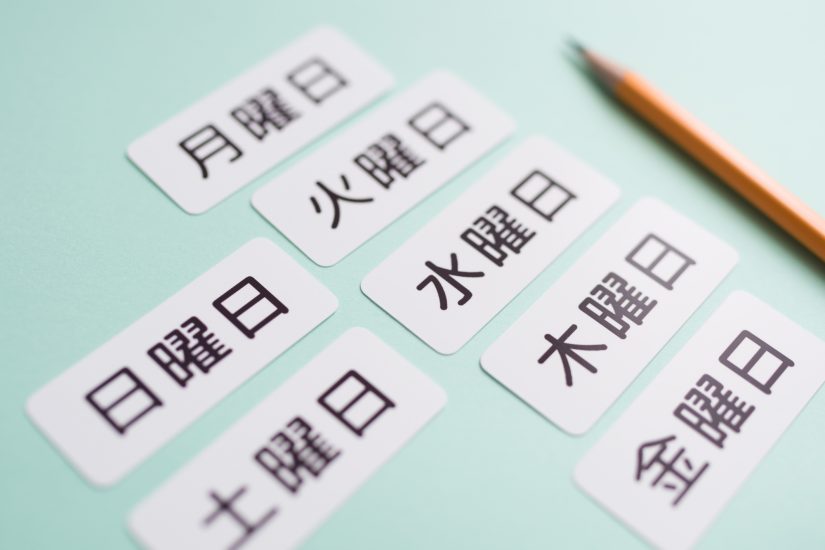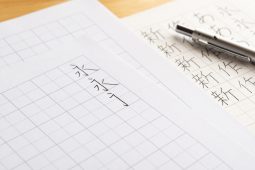In this article we are going to look at the names of the days of the week in Japanese. Not only are these names essential beginners’ vocabulary items, but they also provide a good way to learn some basic kanji. Most of the kanji used for the days of the week are derived from pictographs representing the sun and moon and elemental concepts such fire, water, wood, metal, and earth. This makes them fairly easy to remember. Another bonus is that these kanji frequently reoccur as radicals: the basic components that are used to build other more complex kanji. Without further ado, here are the seven days in Japanese:
| 日曜日 (nichiyōbi) | 月曜日 (getsuyōbi) | 火曜日 (kayōbi) | 水曜日 (suiyōbi) | 木曜日 (mokuyōbi) | 金曜日 (kinyōbi) | 土曜日 (doyōbi) |
| Sunday | Monday | Tuesday | Wednesday | Thursday | Friday | Saturday |
As you can see each day of the week is composed of three characters, and the last two characters are always the same曜日 (yōbi) meaning “day of the week”. Let’s now take a look at the first character for each day of the week and their literal meanings.
| 日 (nichi) | 月 (getsu) | 火 (ka) | 水 (sui) | 木 (moku) | 金 (kin) | 土 (do) |
| sun / day | moon | fire | water | tree / wood | metal / gold | earth / soil |
It doesn’t take too much imagination to see how the kanji 月 derives from a pictograph of a crescent moon, or 水 from a splash of water. Squint your eyes a bit and perhaps you can imagine how primitive sketches of the sun, and fire, and a tree might develop into their kanji representations. Other kanji might be harder to decipher. 金 apparently is derived from an image of metal nuggets buried under the ground, while 土 may show a plant growing from the earth.
You may have noticed by now that in both English and Japanese the first two days of the week are named after the sun and the moon. This may seem like something of a coincidence. But what of the other days? Here’s the interesting thing – they are named after the five visible planets. All you have to do to name these planets in Japanese, is take the kanji above and add 星 which can mean “star” or “planet”. Let’s take a look at these five heavenly bodies:
| 火星 (kasei) | 水星 (suisei) | 木星 (mokusei) | 金星 (kinsei) | 土星 (dosei) |
| Mars | Mercury | Jupiter | Venus | Saturn |
Now if you are familiar with European languages other than English, especially the Romance languages, this system of naming the days after the planets are going to seem awfully familiar. If we look at some examples it should be fairly obvious:
| French | dimanche | lundi | mardi | mercredi | jeudi | vendredi | samedi |
| Spanish | domingo | lunes | martes | miércoles | jueves | viernes | sábado |
| Italian | domenica | lunedì | martedì | mercoledì | giovedì | venerdì | sabato |
The surprising truth is that the names for the days of the week in Japan and in many European languages are derived from a common system. And this common system dates all the way back to ancient Rome. It was the Romans who first named the days of the week after the sun, moon, and planets, and they also named the planets after their gods.
| Day: | Sunday | Monday | Tuesday | Wednesday | Thursday | Friday | Saturday |
| Latin | diēs Sōlis | diēs Lūnae | diēs Mārtis | diēs Mercuriī | diēs Iovis | diēs Veneris | diēs Saturnī |
The Romance languages listed above kept most of the Latin names, but changed the names for Sunday, which was replaced by a name meaning “the Lord’s Day” and for Saturday, which was named after the Sabbath. On the other hand, the Anglo-Saxon ancestors of the English kept Sunday, Monday, and “Saturn’s day”, but otherwise substituted their own equivalent gods for those of Rome. Tuesday is named after Tiw, a god of war; Wednesday after Woden, god of travelers; Thursday after Thor, god of thunder, and Friday after Frigg, goddess of fertility.
The Roman planetary naming system must have travelled via trading routes such as the Silk Road to China and was in use there as early as the 4th century. In China the five visible planets were named after the traditional five elements of Chinese philosophy. This Chinese system was then introduced to Japan, apparently by the great monk Kūkai, sometime in the 9th century. The ancient world was surprisingly well-connected!








